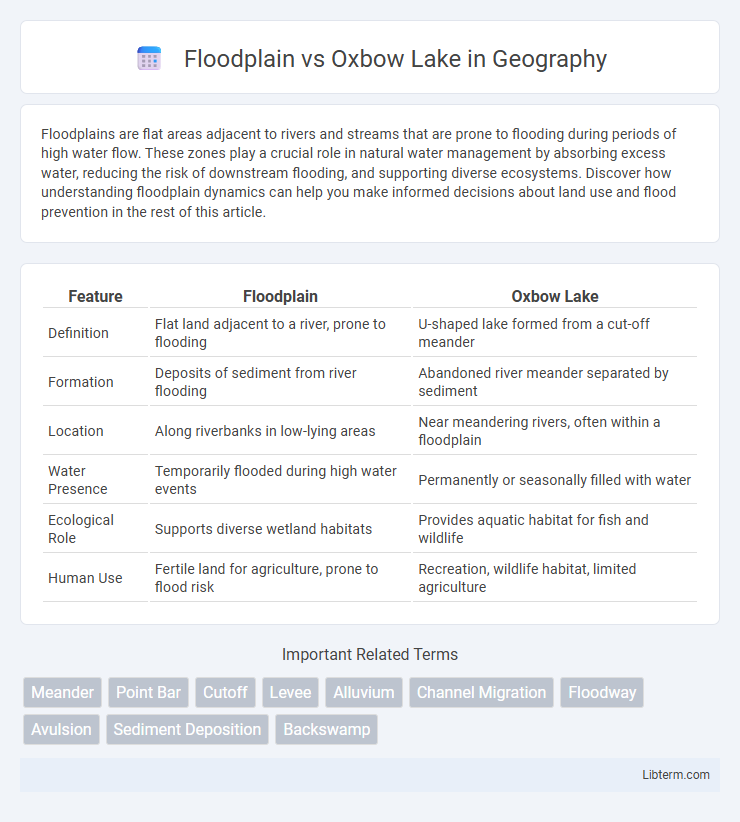Floodplains are flat areas adjacent to rivers and streams that are prone to flooding during periods of high water flow. These zones play a crucial role in natural water management by absorbing excess water, reducing the risk of downstream flooding, and supporting diverse ecosystems. Discover how understanding floodplain dynamics can help you make informed decisions about land use and flood prevention in the rest of this article.
Table of Comparison
| Feature | Floodplain | Oxbow Lake |
|---|---|---|
| Definition | Flat land adjacent to a river, prone to flooding | U-shaped lake formed from a cut-off meander |
| Formation | Deposits of sediment from river flooding | Abandoned river meander separated by sediment |
| Location | Along riverbanks in low-lying areas | Near meandering rivers, often within a floodplain |
| Water Presence | Temporarily flooded during high water events | Permanently or seasonally filled with water |
| Ecological Role | Supports diverse wetland habitats | Provides aquatic habitat for fish and wildlife |
| Human Use | Fertile land for agriculture, prone to flood risk | Recreation, wildlife habitat, limited agriculture |
Introduction to Floodplains and Oxbow Lakes
Floodplains are flat areas adjacent to rivers that experience periodic flooding, playing a vital role in natural water storage and nutrient distribution. Oxbow lakes form when a meander in a river is cut off, creating a crescent-shaped water body that provides unique aquatic habitats. Both features are essential components of riverine ecosystems, influencing biodiversity and landscape dynamics.
Formation Processes: How Floodplains Develop
Floodplains form through the gradual deposition of sediments during periodic river flooding, which creates fertile, flat areas adjacent to the main river channel. As water overflows the banks, it slows down, depositing fine silt and clay that build up the floodplain over time. This sediment accumulation contrasts with oxbow lake formation, which occurs when a river meander is cut off, leaving a crescent-shaped lake isolated from the main channel.
Origins and Creation of Oxbow Lakes
Oxbow lakes form from the natural evolution of river meanders within floodplains, created when a river bends sharply and eventually cuts through the narrow neck of the loop during high flow events. This process isolates the former river channel, leaving a crescent-shaped lake separated from the main stream. Floodplains, flat expanses of land adjacent to rivers, provide the necessary environment for meander formation and the subsequent development of oxbow lakes through sediment deposition and erosion.
Key Physical Characteristics
Floodplains are flat, low-lying areas adjacent to river channels formed by sediment deposition during floods, characterized by fertile soil and periodic inundation. Oxbow lakes are crescent-shaped water bodies created when a river meanders cut off a loop, resulting in isolated, stagnant water separated from the main channel. Floodplains support diverse ecosystems and agriculture, while oxbow lakes often serve as habitats for aquatic plants and wildlife due to their still water conditions.
Differences in Ecosystems and Biodiversity
Floodplains are flat areas adjacent to rivers that experience periodic flooding, supporting diverse ecosystems with nutrient-rich soils and a variety of wetland plants, amphibians, birds, and fish species adapted to fluctuating water levels. Oxbow lakes, formed from cut-off river meanders, provide more stable aquatic habitats with distinct plant and animal communities, including specialized fish, aquatic invertebrates, and birds reliant on calmer water environments. The dynamic flooding of floodplains drives high biodiversity through habitat heterogeneity, while oxbow lakes sustain unique species adapted to isolated, still water conditions.
Hydrological Functions and Water Flow
Floodplains act as natural reservoirs that absorb and slow floodwaters, reducing downstream flooding and replenishing groundwater supplies. Oxbow lakes form from cutoff meanders, serving as isolated water bodies that retain water during dry periods, supporting biodiversity and sediment deposition. Both features contribute to river system stability by regulating water flow dynamics and enhancing aquifer recharge.
Floodplain vs Oxbow Lake: Role in River Dynamics
Floodplains serve as vital zones of sediment deposition and nutrient distribution during river flooding, facilitating ecosystem productivity and stabilizing riverbanks. Oxbow lakes form when meanders are cut off from the main river channel, representing abandoned river segments that influence local hydrology and habitat diversity. Both features play crucial roles in river dynamics by regulating flow regimes, sediment transport, and supporting aquatic and terrestrial biodiversity.
Human Impact and Land Use
Floodplains often face significant human impact through agriculture, urban development, and infrastructure expansion, which can alter natural water flow and increase flood risk. Oxbow lakes are frequently affected by land use changes such as drainage for farming or pollution from nearby settlements, resulting in habitat degradation. Both landscapes require careful management to balance ecological health with human activities and reduce adverse environmental consequences.
Environmental Benefits and Conservation Importance
Floodplains provide critical habitats that support biodiversity by offering nutrient-rich soils and seasonal wetlands essential for various species. Oxbow lakes contribute to ecological health by maintaining aquatic ecosystems and serving as natural water filtration systems that improve water quality. Protecting both floodplains and oxbow lakes enhances flood control, groundwater recharge, and carbon sequestration, making their conservation vital for sustainable environmental management.
Summary: Choosing Between Floodplain and Oxbow Lake
Floodplains offer expansive, flat areas along rivers that promote nutrient-rich soils and support agriculture and biodiversity, while oxbow lakes are crescent-shaped water bodies formed when river meanders are cut off, providing unique aquatic habitats. Choosing between floodplain and oxbow lake management depends on goals such as land use, ecosystem preservation, or flood control. Effective planning requires understanding floodplain dynamics and oxbow lake ecological roles to balance development and conservation objectives.
Floodplain Infographic

 libterm.com
libterm.com